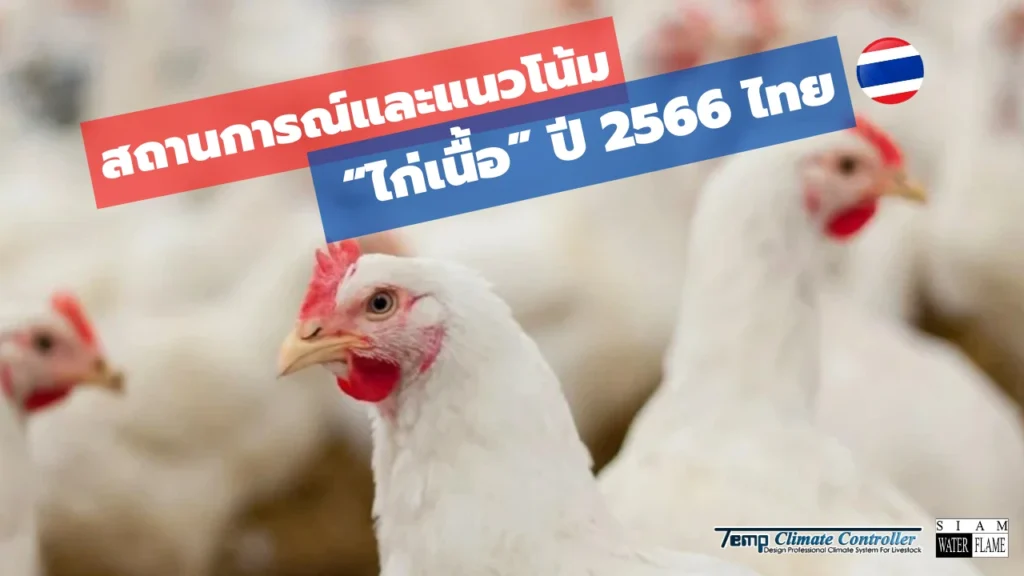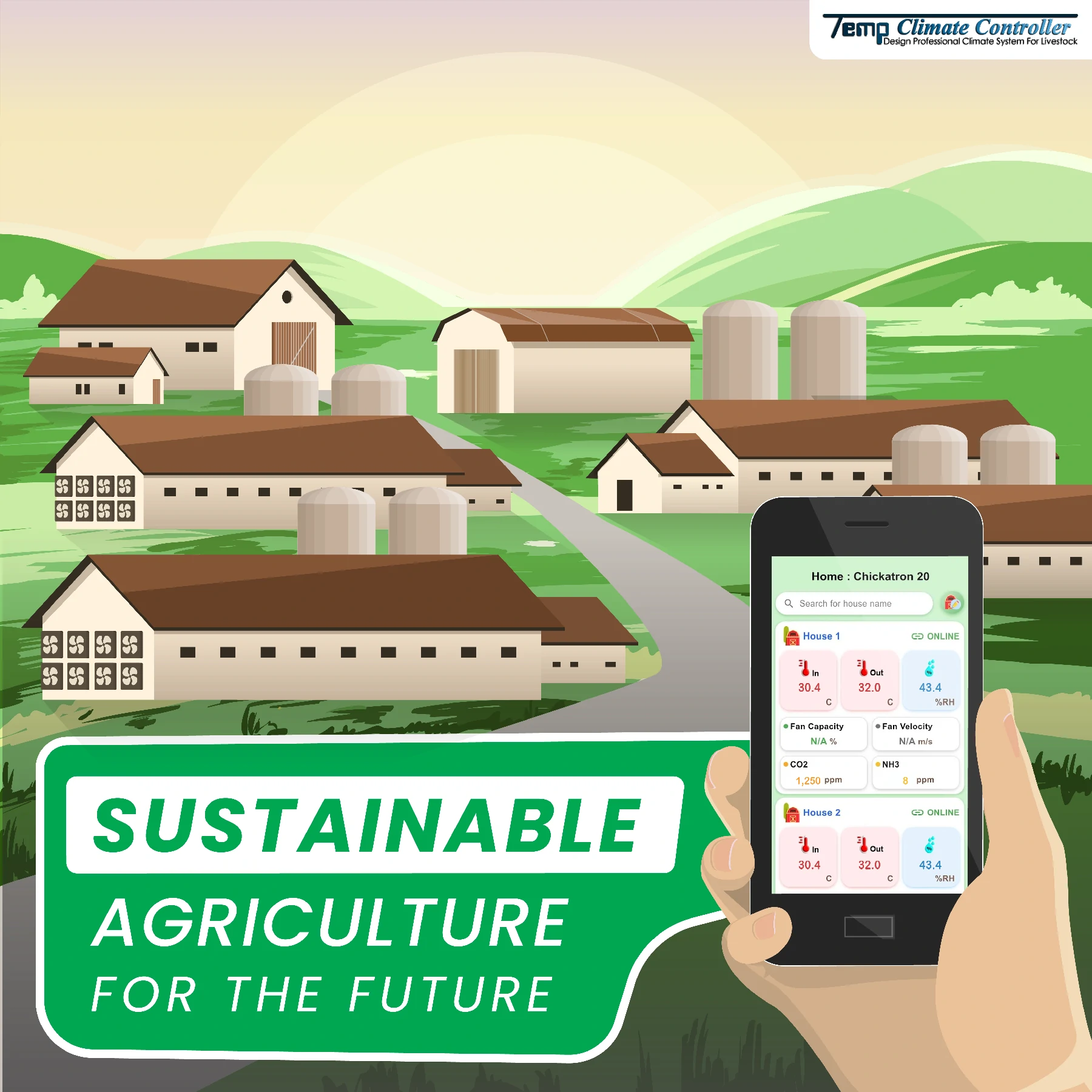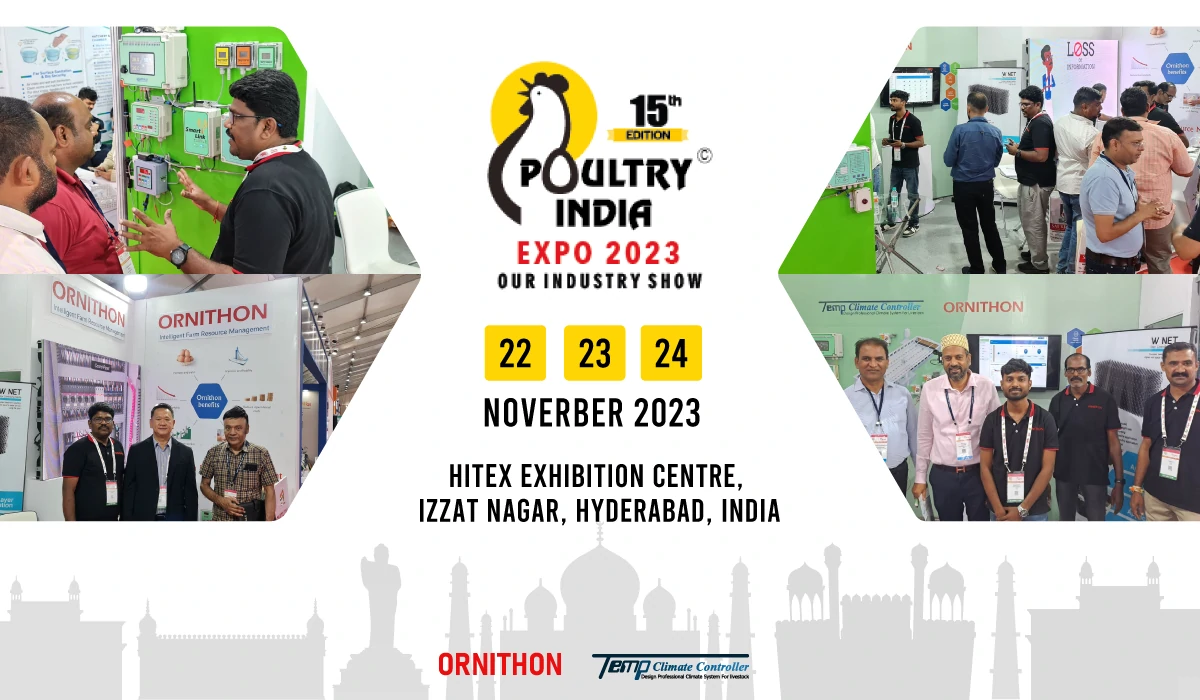Situation and trend of “broiler chicken” in 2023, Thailand
Production
From 2018 to 2022, the production of broiler chicken in Thailand increased at a rate of 3.59% per year. In 2022, there were 1,771.99 million broilers produced, or 2.83 million tons of chicken meat, up from 1,754.04 million, or equivalent to chicken meat. 2.80 million tons in 2021, 1.02% due to increased domestic and international consumption demand from the relaxation of measures to prevent the spread of COVID-19

marketing
consumption
From 2018 to 2022, Thailand’s chicken consumption increased at a rate of 6.94 percent per year. In 2022, there was a consumption of 1.88 million tons of chicken meat, an increase of 0.94 percent from 1.86 million tons in 2021 due to expensive pork. Consumers therefore turn to consume more chicken meat.
Export
Year 2018 – 2022, the amount of export of frozen chicken and Thai processed chicken It tends to increase at a rate of 2.84% per year. In 2022, the total export volume was 0.95 million tons, an increase from 0.94 million tons in 2021, 1.19% divided into
Frozen chicken exports amounted to 0.392 million tons, valued at 42,359 million baht, an increase from the volume of 0.386 million tons, valued at 28,819 million baht in 2021 by 1.24 percent and 46.98 percent respectively. The main frozen chicken export markets are: Japan (38.60%), China (23.40%) and Malaysia (19.53%).
Exports of processed chicken meat amounted to 0.56 million tons, worth 84,133 million baht, an increase from 0.55 million tons, worth 73,709 million baht in 2021, 1.15 percent and 14.14 percent according to the liver. The main export market for processed chicken meat is Japan (percent 47.87), United Kingdom (26.01%), European Union (13.29%) and Korea (5.04%).
Price
Price that farmers can sell
From 2018 to 2022, the price of broiler chickens sold by farmers tends to increase at a rate of 4.35% per year. In 2022, the average price of broiler chickens sold by farmers is 43.75 baht per kg, an increase from 34.87 baht per kg in 2021, 25.47% due to There is an increasing demand for chicken meat to replace pork, coupled with rising production costs. especially the cost of animal feed and energy
Export price
2018 – 2022 export price of frozen chicken And the export price of processed chicken meat tends to increase at a rate of 5.53 percent and 1.50 percent per year according to the liver. In 2022, the average export price of chilled and frozen chicken is 108.20 baht per kilogram, up from 74.53 baht per kilogram of year 2021, 45.18 percent, and the average export price of processed chicken meat is 151.18 baht per kilogram, an increase from 133. 98 baht per kilogram in 2021, 12.84 percent.
Trend for 2023
production
In 2023, it is expected that Thai broiler production will continue to increase according to the population. and growing consumer demand in both domestic and international markets. It is expected that Thailand will produce 1,781.55 million broilers, or 2.85 million tons of chicken meat, up from 1,771.99 million birds, or 2.83 million tons of chicken meat in 2022, 0.54 percent.
Marketing
consumption demand
In 2023, it is expected that Thai chicken meat consumption will be 1.89 million tons, an increase of 0.17 percent from 1.88 million tons in 2022, following the economic recovery. In addition, chicken meat is a protein food that is cheaper than other types of meat. Domestic consumption accounts for 66.26 percent of total
production.
Export
Thai chicken meat exports in 2023 are expected to increase in line with market demand. especially Japan United Kingdom, China and the European Union which tends to import more chicken meat from Thailand from the economic recovery
In 2023, total chicken exports are expected to be 960,000 tons, an increase of 1.27 percent from 948,000 tons in 2022, divided into chilled chicken exports. Frozen meat was 397,000 tons, an increase of 1.40 percent from 391,500 tons in 2022, and processed chicken exports were 563,000 tons, an increase of 1.17 percent from 556,500 tons in 2022.
Price
Price that farmers can sell
In 2023, it is expected that the price of broiler chicken sold by farmers will increase from 2022 because production is planned to be in line with market demand both domestically and internationally. together with the production cost tends to increase
Export price
In 2023, it is expected that the export rate of cold, frozen and processed chicken meat will decrease slightly from 2022 as a result of the exchange rate.
Factors affecting the production or export of Thailand
Positive factor
(1) The economic recovery after the COVID-19 pandemic and the global population increase have led to an increase in the demand for meat, especially chicken meat. Because chicken is a protein food that is low in fat. Including being cheap compared to other types of meat.
(2) The export of chicken meat and its products to foreign countries tends to increase. Especially the Middle East market as a result of the restoration of trade relations between Thailand and Saudi Arabia. Causing Saudi Arabia to lift the ban on importing chicken from Thailand. including the Russo-Ukrainian War resulting in Ukraine There are obstacles in exporting chicken to the EU, so it’s an opportunity for Thai exports.
(3) Operations on Compartment and Traceability can build confidence in the quality of Thai chicken meat production for trading partner countries to accept. as a result of preventive control measures and strict surveillance of animal diseases As a result,
Thailand has not reported avian influenza in Thailand for more than 14 years since the date of the last destruction of poultry on November 12, 2008, as well as the fact that Thailand’s trading partners have certified the standards of its chicken processing and export factories. Thai Therefore, it is an opportunity for Thailand to be able to export more chickens to different markets.

Negative Factor
(1) Thailand depends on production factors. and technology from foreign countries such as animal breeds, raw materials, animal feed, drugs and medical supplies Moreover, the cost of Thai broiler production is comparatively higher than that of competitors such as Brazil and the United States. especially the cost of animal feed
(2) Countries are increasingly adopting non-tariff measures (NTMs) by incorporating various social issues into international trade standards, such as labor standards. environmental standards, etc., which trading partners may use such issues to prevent trade between them. If Thailand does not have serious preparations for prevention and remediation It may affect the export of Thai chicken meat.
(3) foreign exchange rates Because broiler chicken and other agricultural products are important export products of Thailand. If the exchange rate fluctuates, it will reduce the ability to compete on price with competitors.
Situation and trend of “broiler chicken” in 2023, Thailand
Production
From 2018 to 2022, the production of broiler chicken in Thailand increased at a rate of 3.59% per year. In 2022, there were 1,771.99 million broilers produced, or 2.83 million tons of chicken meat, up from 1,754.04 million, or equivalent to chicken meat. 2.80 million tons in 2021, 1.02% due to increased domestic and international consumption demand from the relaxation of measures to prevent the spread of COVID-19
Marketing
consumption
From 2018 to 2022, Thailand’s chicken consumption increased at a rate of 6.94 percent per year. In 2022, there was a consumption of 1.88 million tons of chicken meat, an increase of 0.94 percent from 1.86 million tons in 2021 due to expensive pork. Consumers therefore turn to consume more chicken meat.

Export
Year 2018 – 2022, the amount of export of frozen chicken and Thai processed chicken It tends to increase at a rate of 2.84% per year. In 2022, the total export volume was 0.95 million tons, an increase from 0.94 million tons in 2021, 1.19% divided into
Frozen chicken exports amounted to 0.392 million tons, valued at 42,359 million baht, an increase from the volume of 0.386 million tons, valued at 28,819 million baht in 2021 by 1.24 percent and 46.98 percent respectively. The main frozen chicken export markets are: Japan (38.60%), China (23.40%) and Malaysia (19.53%).
Exports of processed chicken meat amounted to 0.56 million tons, worth 84,133 million baht, an increase from 0.55 million tons, worth 73,709 million baht in 2021, 1.15 percent and 14.14 percent according to the liver. The main export market for processed chicken meat is Japan (percent 47.87), United Kingdom (26.01%), European Union (13.29%) and Korea (5.04%).
price
price that farmers can sell
From 2018 to 2022, the price of broiler chickens sold by farmers tends to increase at a rate of 4.35% per year. In 2022, the average price of broiler chickens sold by farmers is 43.75 baht per kg, an increase from 34.87 baht per kg in 2021, 25.47% due to There is an increasing demand for chicken meat to replace pork, coupled with rising production costs. especially the cost of animal feed and energy
export price
2018 – 2022 export price of frozen chicken And the export price of processed chicken meat tends to increase at a rate of 5.53 percent and 1.50 percent per year according to the liver. In 2022, the average export price of chilled and frozen chicken is 108.20 baht per kilogram, up from 74.53 baht per kilogram of year 2021, 45.18 percent, and the average export price of processed chicken meat is 151.18 baht per kilogram, an increase from 133. 98 baht per kilogram in 2021, 12.84 percent.
Trend for 2023
production
In 2023, it is expected that Thai broiler production will continue to increase according to the population. and growing consumer demand in both domestic and international markets. It is expected that Thailand will produce 1,781.55 million broilers, or 2.85 million tons of chicken meat, up from 1,771.99 million birds, or 2.83 million tons of chicken meat in 2022, 0.54 percent.
marketing
consumption demand
In 2023, it is expected that Thai chicken meat consumption will be 1.89 million tons, an increase of 0.17 percent from 1.88 million tons in 2022, following the economic recovery. In addition, chicken meat is a protein food that is cheaper than other types of meat. Domestic consumption accounts for 66.26 percent of total production.

Export
Thai chicken meat exports in 2023 are expected to increase in line with market demand. especially Japan United Kingdom, China and the European Union which tends to import more chicken meat from Thailand from the economic recovery
In 2023, total chicken exports are expected to be 960,000 tons, an increase of 1.27 percent from 948,000 tons in 2022, divided into chilled chicken exports. Frozen meat was 397,000 tons, an increase of 1.40 percent from 391,500 tons in 2022, and processed chicken exports were 563,000 tons, an increase of 1.17 percent from 556,500 tons in 2022.
price
price that farmers can sell
In 2023, it is expected that the price of broiler chicken sold by farmers will increase from 2022 because production is planned to be in line with market demand both domestically and internationally. together with the production cost tends to increase
export price
In 2023, it is expected that the export rate of cold, frozen and processed chicken meat will decrease slightly from 2022 as a result of the exchange rate.
Factors affecting the production or export of Thailand
positive factor
(1) The economic recovery after the COVID-19 pandemic and the global population increase have led to an increase in the demand for meat, especially chicken meat. Because chicken is a protein food that is low in fat. Including being cheap compared to other types of meat.
(2) The export of chicken meat and its products to foreign countries tends to increase. Especially the Middle East market as a result of the restoration of trade relations between Thailand and Saudi Arabia. Causing Saudi Arabia to lift the ban on importing chicken from Thailand. including the Russo-Ukrainian War resulting in Ukraine There are obstacles in exporting chicken to the EU, so it’s an opportunity for Thai exports.

(3) Operations on Compartment and Traceability can build confidence in the quality of Thai chicken meat production for trading partner countries to accept. as a result of preventive control measures and strict surveillance of animal diseases As a result,
Thailand has not reported avian influenza in Thailand for more than 14 years since the date of the last destruction of poultry on November 12, 2008, as well as the fact that Thailand’s trading partners have certified the standards of its chicken processing and export factories. Thai Therefore, it is an opportunity for Thailand to be able to export more chickens to different markets.
Negative factor
(1) Thailand depends on production factors. and technology from foreign countries such as animal breeds, raw materials, animal feed, drugs and medical supplies Moreover, the cost of Thai broiler production is comparatively higher than that of competitors such as Brazil and the United States. especially the cost of animal feed
(2) Countries are increasingly adopting non-tariff measures (NTMs) by incorporating various social issues into international trade standards, such as labor standards. environmental standards, etc., which trading partners may use such issues to prevent trade between them. If Thailand does not have serious preparations for prevention and remediation It may affect the export of Thai chicken meat.
(3) foreign exchange rates Because broiler chicken and other agricultural products are important export products of Thailand. If the exchange rate fluctuates, it will reduce the ability to compete on price with competitors.
Situation and trend of “broiler chicken” in 2023, Thailand
Production
From 2018 to 2022, the production of broiler chicken in Thailand increased at a rate of 3.59% per year. In 2022, there were 1,771.99 million broilers produced, or 2.83 million tons of chicken meat, up from 1,754.04 million, or equivalent to chicken meat. 2.80 million tons in 2021, 1.02% due to increased domestic and international consumption demand from the relaxation of measures to prevent the spread of COVID-19
marketing
consumption
From 2018 to 2022, Thailand’s chicken consumption increased at a rate of 6.94 percent per year. In 2022, there was a consumption of 1.88 million tons of chicken meat, an increase of 0.94 percent from 1.86 million tons in 2021 due to expensive pork. Consumers therefore turn to consume more chicken meat.

Export
Year 2018 – 2022, the amount of export of frozen chicken and Thai processed chicken It tends to increase at a rate of 2.84% per year. In 2022, the total export volume was 0.95 million tons, an increase from 0.94 million tons in 2021, 1.19% divided into
Frozen chicken exports amounted to 0.392 million tons, valued at 42,359 million baht, an increase from the volume of 0.386 million tons, valued at 28,819 million baht in 2021 by 1.24 percent and 46.98 percent respectively. The main frozen chicken export markets are: Japan (38.60%), China (23.40%) and Malaysia (19.53%).
Exports of processed chicken meat amounted to 0.56 million tons, worth 84,133 million baht, an increase from 0.55 million tons, worth 73,709 million baht in 2021, 1.15 percent and 14.14 percent according to the liver. The main export market for processed chicken meat is Japan (percent 47.87), United Kingdom (26.01%), European Union (13.29%) and Korea (5.04%).
price
price that farmers can sell
From 2018 to 2022, the price of broiler chickens sold by farmers tends to increase at a rate of 4.35% per year. In 2022, the average price of broiler chickens sold by farmers is 43.75 baht per kg, an increase from 34.87 baht per kg in 2021, 25.47% due to There is an increasing demand for chicken meat to replace pork, coupled with rising production costs. especially the cost of animal feed and energy
export price
2018 – 2022 export price of frozen chicken And the export price of processed chicken meat tends to increase at a rate of 5.53 percent and 1.50 percent per year according to the liver. In 2022, the average export price of chilled and frozen chicken is 108.20 baht per kilogram, up from 74.53 baht per kilogram of year 2021, 45.18 percent, and the average export price of processed chicken meat is 151.18 baht per kilogram, an increase from 133. 98 baht per kilogram in 2021, 12.84 percent.
Trend for 2023
production
In 2023, it is expected that Thai broiler production will continue to increase according to the population. and growing consumer demand in both domestic and international markets. It is expected that Thailand will produce 1,781.55 million broilers, or 2.85 million tons of chicken meat, up from 1,771.99 million birds, or 2.83 million tons of chicken meat in 2022, 0.54 percent.
marketing
consumption demand
In 2023, it is expected that Thai chicken meat consumption will be 1.89 million tons, an increase of 0.17 percent from 1.88 million tons in 2022, following the economic recovery. In addition, chicken meat is a protein food that is cheaper than other types of meat. Domestic consumption accounts for 66.26 percent of total production.
Export
Thai chicken meat exports in 2023 are expected to increase in line with market demand. especially Japan United Kingdom, China and the European Union which tends to import more chicken meat from Thailand from the economic recovery
In 2023, total chicken exports are expected to be 960,000 tons, an increase of 1.27 percent from 948,000 tons in 2022, divided into chilled chicken exports. Frozen meat was 397,000 tons, an increase of 1.40 percent from 391,500 tons in 2022, and processed chicken exports were 563,000 tons, an increase of 1.17 percent from 556,500 tons in 2022.
price
price that farmers can sell
In 2023, it is expected that the price of broiler chicken sold by farmers will increase from 2022 because production is planned to be in line with market demand both domestically and internationally. together with the production cost tends to increase
export price
In 2023, it is expected that the export rate of cold, frozen and processed chicken meat will decrease slightly from 2022 as a result of the exchange rate.
Factors affecting the production or export of Thailand
positive factor
(1) The economic recovery after the COVID-19 pandemic and the global population increase have led to an increase in the demand for meat, especially chicken meat. Because chicken is a protein food that is low in fat. Including being cheap compared to other types of meat.
(2) The export of chicken meat and its products to foreign countries tends to increase. Especially the Middle East market as a result of the restoration of trade relations between Thailand and Saudi Arabia. Causing Saudi Arabia to lift the ban on importing chicken from
Thailand. including the Russo-Ukrainian War resulting in Ukraine There are obstacles in exporting chicken to the EU, so it’s an opportunity for Thai exports.
(3) Operations on Compartment and Traceability can build confidence in the quality of Thai chicken meat production for trading partner countries to accept. as a result of preventive control measures and strict surveillance of animal diseases As a result,
Thailand has not reported avian influenza in Thailand for more than 14 years since the date of the last destruction of poultry on November 12, 2008, as well as the fact that Thailand’s trading partners have certified the standards of its chicken processing and export factories. Thai Therefore, it is an opportunity for Thailand to be able to export more chickens to different markets.















Pingback:Bone fracture disease in laying hens and broilers.